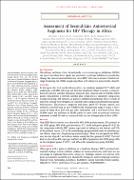| dc.contributor.author | Paton, I. Nicholas | |
| dc.contributor.author | Kityo, Cissy | |
| dc.contributor.author | Hoppe, Anne | |
| dc.contributor.author | Reid, Andrew | |
| dc.contributor.author | Kambugu, Andrew | |
| dc.contributor.author | Lugemwa, Abbas | |
| dc.contributor.author | Oosterhout, van J. Joep | |
| dc.contributor.author | Kiconco, Mary | |
| dc.contributor.author | Siika, Abraham | |
| dc.contributor.author | Mwebaze, Raymond | |
| dc.contributor.author | Abwola, Mary | |
| dc.contributor.author | Abongomera, George | |
| dc.contributor.author | Mweemba, Aggrey | |
| dc.contributor.author | Alima, Hillary | |
| dc.contributor.author | Atwongyeire, Dickens | |
| dc.contributor.author | Nyirenda, Rose | |
| dc.contributor.author | Boles, Justine | |
| dc.contributor.author | Thompson, Jennifer | |
| dc.contributor.author | Tumukunde, Dinah | |
| dc.contributor.author | Chidziva, Ennie | |
| dc.contributor.author | Mambule, Ivan | |
| dc.contributor.author | Arribas, R. Jose | |
| dc.contributor.author | Easterbrook, J. Philippa | |
| dc.contributor.author | Hakim, James | |
| dc.contributor.author | Walker, Sarah A. | |
| dc.contributor.author | Mugyenyi, Peter | |
| dc.date.accessioned | 2021-04-21T14:23:27Z | |
| dc.date.available | 2021-04-21T14:23:27Z | |
| dc.date.issued | 2014-07-17 | |
| dc.identifier.citation | Paton, N.I., Kityo, C., Hoppe, A., Reid, A., Kambugu, A., Lugemwa, A., van Oosterhout, J.J., Kiconco, M., Siika, A., Mwebaze, R. and Abwola, M., 2014. Assessment of second-line antiretroviral regimens for HIV therapy in Africa. New England journal of medicine, 371(3), pp.234-247. | en_US |
| dc.identifier.issn | 1533-4406 | |
| dc.identifier.issn | 0028-4793. | |
| dc.identifier.uri | http://hdl.handle.net/20.500.12280/2684 | |
| dc.description.abstract | Background
The efficacy and toxic effects of nucleoside reverse-transcriptase inhibitors (NRTIs) are uncertain when these agents are used with a protease inhibitor in second-line therapy for human immunodeficiency virus (HIV) infection in resource-limited settings. Removing the NRTIs or replacing them with raltegravir may provide a benefit.
Methods
In this open-label trial in sub-Saharan Africa, we randomly assigned 1277 adults and adolescents with HIV infection and first-line treatment failure to receive a ritonavir-boosted protease inhibitor (lopinavir–ritonavir) plus clinician-selected NRTIs (NRTI group, 426 patients), a protease inhibitor plus raltegravir in a superiority comparison (raltegravir group, 433 patients), or protease-inhibitor monotherapy after 12 weeks of induction therapy with raltegravir in a noninferiority comparison (monotherapy group, 418 patients). The primary composite end point, good HIV disease control, was defined as survival with no new World Health Organization stage 4 events, a CD4+ count of more than 250 cells per cubic millimeter, and a viral load of less than 10,000 copies per milliliter or 10,000 copies or more with no protease resistance mutations at week 96 and was analyzed with the use of imputation of data (≤4%).
Results
Good HIV disease control was achieved in 60% of the patients (mean, 255 patients) in the NRTI group, 64% of the patients (mean, 277) in the raltegravir group (P=0.21 for the comparison with the NRTI group; superiority of raltegravir not shown), and 55%
of the patients (mean, 232) in the monotherapy group (noninferiority of monotherapy
not shown, based on a 10-percentage-point margin). There was no significant differ ence in rates of grade 3 or 4 adverse events among the three groups (P=0.82). The viral load was less than 400 copies per milliliter in 86% of patients in the NRTI group, 86%
in the raltegravir group (P=0.97), and 61% in the monotherapy group (P<0.001).
Conclusions
When given with a protease inhibitor in second-line therapy, NRTIs retained substantial virologic activity without evidence of increased toxicity, and there was no advantage to replacing them with raltegravir. Virologic control was inferior with protease-inhibitor monotherapy. (Funded by European and Developing Countries Clinical Trials Partnership and others; EARNEST Current Controlled Trials number, ISRCTN 37737787, and ClinicalTrials.gov number, NCT00988039.) | en_US |
| dc.language.iso | en | en_US |
| dc.publisher | Massachusetts Medical Society. | en_US |
| dc.relation.ispartofseries | New England journal of medicine;371(3) | |
| dc.subject | Assessment | en_US |
| dc.subject | Antiretroviral Regimens | en_US |
| dc.subject | HIV Therapy | en_US |
| dc.subject | Africa | en_US |
| dc.title | Assessment of Second-Line Antiretroviral Regimens for HIV Therapy in Africa | en_US |
| dc.type | Article | en_US |


